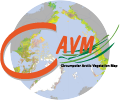
Course Archive
- All Past Courses
- BIOL 474
- BIOL 475/689
- BIOL 492/692
- BIOL 493/693
- BIOL 697
- 2010 IARC Field School
- Fulbright Scholar Lectures, Masaryk University
- Current and Recent Courses
BIOL 475/689: Vegetation Description and Analysis (3 credits)
Fall 2012 -
Syllabus: General information & grading -
Course schedule -
Full Syllabus (PDF, revised Nov. 20)
Lab Handouts & Reading materials (PDFs)
Additional resources: Plant List - Plant Characteristics - Plant Keys
Course information
- Title: Vegetation Description and Analysis
- Number: BIOL 475/689
- Credits: 3
- Prerequisites: BIOL 115, BIOL 116; BIOL 239 Introduction to Plant Biology, or BIOL 271 Principles of Ecology, or BIOL 331 Plant Systematics, or permission of instructor
- Location:
- Lecture: 208 Irving I
- Lab: 303 Irving I (also field trips [mostly within North Campus Lands], 335 O'Neill and 301 Bunnel)
- Meeting time:
- Lecture: M 2:15-4:15
- Lab: W 2:15-5:15
Instructor
- Prof. D.A. (Skip) Walker
- Alaska Geobotany Center, University of Alaska Fairbanks
- AHRB 252/254
- 474-2460
- dawalker@alaska.edu
- Office hours: T/TH 09:00-12:00
- Students are encouraged to contact the instructor with any questions, or to clarify the lecture or the assignments.
I will be happy to review drafts of assignments and answer questions any time.
Teaching Assistant (TA)
- Mark Winterstein
- AHRB 132
- 474-2652
- mawinterstein@alaska.edu
- Office hours: Tuesday, 1 p.m. - 3 p.m. or by appointment
Course Readings/Materials
Recommended reading will include sections of books, relevant journal articles and reports to supplement the material covered in class. I would recommend purchasing Kent (2012) and McCune and Grace (2002) as good general references for the course. Most of the reading will be from these two texts. This reading is recommended to broaden students' understanding of the topics and fill any gaps in students' background, and is required if a student is having difficulty understanding a topic. Some materials are included so students can peruse and become familiar with the reference material available.
Those materials that are available electronically will be put on the class web site Reading Materials page. Books will be put on reserve in the Biosciences Library in the Arctic Health Building. These will include:
- Kent, M. 2012. Vegetation description and data analysis: a practical approach. New York, John Wiley.
- Mueller-Dombois, L. D. and Ellenberg, H., 1974: Aims and Methods of Vegetation Ecology. John Wiley and Sons, New York (reprinted in 2003 by Blackburn Press).
- McCune, B. and Grace, J., 2002: Analysis of ecological communities. Gleneden Beach, Oregon: MjM Software Design, 300 pp.
- Tichý L and Holt J 2011 JUICE program for management, analysis and classification of ecological data, 2nd Edition of Program Manual (Brno: Vegetation Science Group, Masaryk University).
Required supplies
- 10x-power hand lens for field identification of plants
- 8.5 x 11 inch notebook for field reference collection and methods notes
- Clothing adequate for spending several hours outdoors conducting field work (including day pack, rain gear (top & bottom), waterproof boots, coat/sweater, hat, gloves)
Evaluation
Summary of grading points
| Undergraduate students: | Graduate students | |
|---|---|---|
| Attendance (30 points @ 10 points/class) | 300 | 300 |
| Vegetation descriptions (2 @ 100 points each) | 200 | 200 |
| Lab report assignments (4 @ 100 points/report) | 400 | 400 |
| Vegetation description & analysis notebook | 200 | 200 |
| Final paper proposal and outline | 50 | 50 |
| Final paper: | 100 | 300 |
| Oral presentation to class | 100 | 200 |
| TOTAL | 1350 points | 1600 points |
Undergraduate student expectations and grading
- Attend all lectures, literature discussion groups, labs and exams on time. There will be no make-up for missed classes and half credit for late attendance. Good reasons for missing the classes will be accepted if cleared with the instructor before the class. (10 points for each for 30 sessions, 300 total points).
- Written lab reports describing the methods and the results of the exercise (four reports @100 points = 400 total points). Expectations for lab reports will be provided at each lab.
- Vegetation descriptions and analysis notebook (see syllabus for description and contents). The notebook will be checked twice during the semester and handed in at the end for a grade (200 points).
- The final paper (described in the syllabus) is worth 100 points for undergraduate students. Guidelines and grading criteria for the paper will be handed out early in the semester. Five percent will be deducted for each day the paper is late. Students should arrange for an incomplete grade if they cannot meet the deadline.
- Twenty-minute oral presentation of the final paper (described above in the syllabus) is worth 100 points for undergraduate students. Guidelines and grading criteria for the presentations will be handed out early in the semester.
Additional expectations for graduate students and grading
- The final paper for graduate students is expected to use 2-3 analytical methods, and be more of a synthesis of either the class sampling activities, or the analysis of data set of the student's choosing. The paper is worth 300 points.
- The final oral presentation for graduate students will be somewhat longer than for undergraduates (30 minutes), cover more material, and provide a more thorough analysis of the vegetation of the topic. The presentation is worth 200 points.
- The graduate student literature presentations are worth 100 points. (only if we have an extra class session).
Note: These criteria may be modified somewhat as the course progresses.
Final grades will be as follows: greater than or equal to 90% = A; 80-89% = B; 70-79% = C; 60-69% = D; < 60% = F
Assignments are due at the beginning of class on the days shown in the schedule. 5% of the total points will be deducted for every day an assignment is late.







